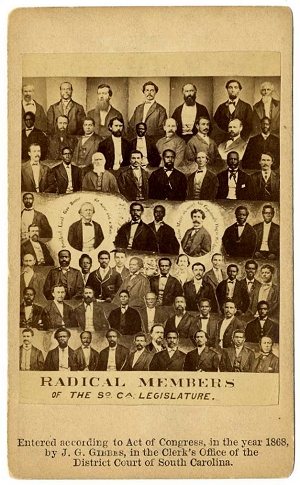 |
| General Oliver Howard |
 |
| Political Cartoon of Pres. Johnson Vetoing Freedmen's Bureau Policies |
 |
| Anti-Freedman's Bureau Advertisement |
 |
| Radical Republicans of South Carolina |
 |
| Howard University Faculty, 1900 |
 |
| J. Stanley Durkee |
 |
| Dr. Mordecai Johnson with African-American Opera Singer, Marian Anderson, and Others |
 |
| Dr. Charles Drew (2nd left) with other Howard University Faculty |
Howard University has played an important role in American history and the Civil Rights Movement on a number of occasions. Alain Locke, Chair of the Department of Philosophy and the first African-American Rhodes Scholar, authored The New Negro, which precluded the dawn of the Harlem Renaissance.
 |
| Alain Locke |
Beginning in 1942, Howard University students pioneered the "stool-sitting" technique, which was to play a prominent role in the later Civil Rights Movement. By January, 1943, students had begun to organize regular sit-ins and pickets at cigar stores and cafeterias around Washington, D.C. which refused to serve them because of their race. These protests continued until the administration asked the students to stop, in the Autumn of 1944. Stokely Carmichael, a student in the Department of Philosophy and the Howard University School of Divinity coined the term "Black Power" and worked as a voting rights activist.
 |
| Stokely Carmichael on the cover of EBONY magazine |
In 1960, Senator John F. Kennedy spoke at Howard during his Presidential campaign, highlighting the future of African-Americans under his (hopeful) Presidency. In 1965, President Lyndon B. Johnson delivered a speech to the graduating class at Howard, where he outlined his plans for Civil Rights legislation and endorsed aggressive affirmative action to combat the effects of years of segregation of African-Americans from economic progress.
 |
| John F. Kennedy Speaking at Howard University |
 |
| Thank You Telegram from Dr. Martin Luther King, Jr. to President Lyndon B. Johnson |
In 1989, Howard gained national attention when students rose up in protest against the appointment of then-Republican National Committee Chairman, Lee Atwater, as a new member of the University's Board of Trustees. Student activists staged a protest and occupied the University's Administration building. Within days, both Atwater and Howard's President, James E. Cheek, had resigned.
One of the more recent Howard University Presidents was H. Patrick Swygert, from 1995 to 2008. He was a 1965 Howard University, and well as a Howard University Law School graduate; and for most of his tenure, he was extremely popular. However, in April 2007, it seemed time to inject new life into the University, as it had been suffering administrative and financial problems. So, President Swygert retired in 2008.
 |
| President Swygert with President Obama |
 |
| Dr. Sidney Ribeau |
Succeeding Dr. Ribeau was Dr. Wayne A.I. Frederick, who is Howard's current and 17th President. Dr. Frederick is a Howard alum, earned an MBA, and is an award-winning oncology surgeon. The early years of his tenure were a bit rocky, beginning with students being extremely unhappy with his visit to The White House, in 2017, along with dozens of other Presidents of Historically Black Colleges and Universities (HBCUs), in their hope of securing additional federal funding. However, he now seems to be on a much more positive path, with public support of the Alumni Association.
Of course, it’s not all about the academics. To name a few extra-curricular activities on offer, there are several sororities and fraternities, NCAA sports programs, The Howard University "Showtime" Marching Band and The Hilltop, founded in 1924 by Howard University student and celebrated,
Harlem Renaissance author, Zora Neale Hurston.
The most recent US News & World Report’s College and University Ranking places Howard as the #2 HBCU in the country. Between1998 and 2009, Howard University produced a Marshall Scholar, two Rhodes Scholars, two Truman Scholars, twenty-two Fulbright Scholars and ten Pickering Fellows. Howard also produces more on-campus African-American Ph.D. degrees than any other university in the world, and the most African-American students attending medical school in the U.S.
In addition to aforementioned alumni, Howard boasts a very long list of esteemed alumni – so long, that I have only chosen a few to name:
Emmy & Golden Globe-winning choreographer, actress and singer, Debbie Allen; the first Nigerian President, Nnamdi Azikiwe; actress Taraji P. Henson; Dr. LaSalle LeFall, the first Black President of the
American Cancer Society; Thurgood Marshall, former U.S. Supreme Court Justice; Nobel Prize and Pulitzer Prize-winning author, Toni Morrison; Congressman, Elijah Cummings; and Senator Kamala Harris.
 |
| Nigerian President, Nnamdi Azikiwe |
 |
| Toni Morrison |











No comments:
Post a Comment